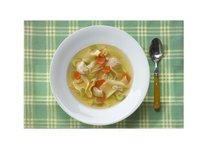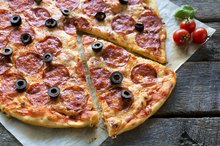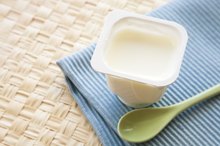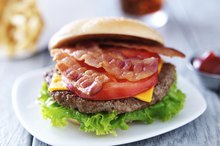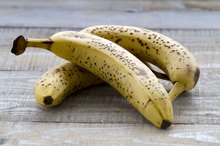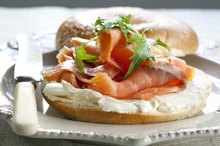Foods That Help Panic Attacks
A panic attack is an episode of intense fear that comes on suddenly, often for no apparent reason. In addition to emotional symptoms, panic attacks may cause a rapid heartbeat, sweating, breathing difficulties, abdominal pain and nausea. You may experience one, occasional or frequent panic attacks, which typically indicate an anxiety disorder. Treatment for anxiety disorders involving panic attacks often include medications, psychotherapy and relaxation techniques. Dietary changes may also help prevent or minimize your symptoms.
Whole Grains
Whole grains are grains that have retained nutrient, fiber and protein content during food processing. As a result, whole grains digest slower than refined grain products, such as white flour, and have a positive impact on your blood sugar levels. Blood sugar management is a useful dietary step toward preventing panic attacks according to J. Stevenson, author of "Anxiety Disorders: Concise Blueprint To Overcome Panic Attacks, Phobia & Anxiety." Replacing processed snack foods with whole grain foods most often, according to Stevenson, can help prevent mood swings and promote relaxation. Examples of nutritious whole grain foods include 100 percent whole grain breads and cold cereals, old-fashioned oatmeal, long grain brown rice, quinoa, pearled barley and air popped popcorn.
- Whole grains are grains that have retained nutrient, fiber and protein content during food processing.
- Replacing processed snack foods with whole grain foods most often, according to Stevenson, can help prevent mood swings and promote relaxation.
Dairy Products
Why Do People Need to Eat Healthy Foods?
Learn More
Dairy products, such as milk, yogurt and cheese, are valuable sources of calcium, vitamin D and protein, which also help stabilize blood sugar levels. Dairy products also contains tryptophan, an amino acid that helps your brain produce chemicals associated with calmness, according to MayoClinic.com psychiatrist Dr. Daniel K. Hall-Flavin. To prevent excessive intake of saturated fat, consume lean varieties, such as skim or low fat milk and yogurt, kefir -- a yogurt-like beverage and part-skim mozzarella cheese most often.
Fruits and Vegetables
Fruits and vegetables are prime sources of antioxidants -- nutrients that help your body protect itself from disease and infections. Stevenson recommends incorporating fruits and vegetables into starch-based meals for improved blood sugar management and mood balance. Rather than eat enriched pasta alone, for example, top whole grain pasta with cooked vegetables and tomato sauce and add colorful berries or banana slices to oatmeal and cold cereals. Some fruits and vegetables, such as bananas and baked potatoes, also contain tryptophan.
- Fruits and vegetables are prime sources of antioxidants -- nutrients that help your body protect itself from disease and infections.
- Stevenson recommends incorporating fruits and vegetables into starch-based meals for improved blood sugar management and mood balance.
Fish and Poultry
Diet Plan for Compulsive Eating
Learn More
Fish and poultry provide rich amounts of protein and nutrients, including B-vitamins, iron and zinc. The University of Maryland Medical Center recommends balanced meals, containing protein, complex carbohydrates and healthy fat, for improved anxiety symptoms and overall wellness. Turkey and chicken are additional tryptophan-rich foods. Fatty fish, such as salmon, albacore tuna, lake trout, flounder and halibut, provide omega-3 fatty acids -- healthy fats that promote positive brain function and may help relieve depressive symptoms associated with anxiety disorders. Chose white meat, skinless poultry over dark meat poultry, which is high in saturated fat.
- Fish and poultry provide rich amounts of protein and nutrients, including B-vitamins, iron and zinc.
- Fatty fish, such as salmon, albacore tuna, lake trout, flounder and halibut, provide omega-3 fatty acids -- healthy fats that promote positive brain function and may help relieve depressive symptoms associated with anxiety disorders.
Related Articles
References
- MayoClinic.com: Coping with Anxiety: Can Diet Make a Difference?
- "Anxiety Disorders: Concise Blueprint To Overcome Panic Attacks, Phobia & Anxiety"; J. Stevenson; 2008
- Locke AB, Kirst N, Shultz CG. Diagnosis and management of generalized anxiety disorder and panic disorder in adults. Am Fam Physician. 2015;91(9):617-24.
- Gregory KD, Chelmow D, Nelson HD, et al. Screening for anxiety in adolescent and adult women: A recommendation from the Women's Preventive Services Initiative. Ann Intern Med. 2020. doi:10.7326/M20-0580
- American Psychiatric Association. Diagnostic and Statistical Manual of Mental Disorders. 5th ed. Washington D.C.: 2013. doi:10.1176/appi.books.9780890425596
Writer Bio
August McLaughlin is a certified nutritionist and health writer with more than nine years of professional experience. Her work has been featured in various magazines such as "Healthy Aging," "CitySmart," "IAmThatGirl" and "ULM." She holds specializations in eating disorders, healthy weight management and sports nutrition. She is currently completing her second cookbook and Weight Limit—a series of body image/nutrition-related PSAs.


